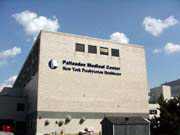The New Jersey State Department of Environmental Protection said last week that it would further investigate a claim from a former New Jersey contractor who says that dangerous asbestos was used in the landfill during construction of the Palisades General Medical Center in the late ’60s and early ’70s.
According to state DEP spokesman Scott Sullivan, the state agency will reopen the file regarding the construction of the hospital, located on River Road in North Bergen, after reading the claims from a worker who insists cancer-causing contaminants like asbestos and Styrofoam were dumped at the site from an Edgewater chemical factory.
"Any time the word ‘asbestos’ comes up in the course of investigations, we have to take it very seriously," Sullivan said last week. "Although our initial reports show no evidence of any contaminants at the site, we will, at the very least, look into the allegations."
According to correspondence from former North Bergen resident Robert McCann, currently residing in Daytona Beach, Fla., many truckloads of asbestos sheetrock and Styrofoam were dumped daily between 1966 and 1970 at the site where the hospital was eventually built.
"I’d say that at least a dozen 10-ton trucks were dumped there every day," said McCann, who was hired to transport the waste from the now-defunct Celotex chemical company in nearby Edgewater.
When the dumping took place, there were no state or federal regulations regarding the use of asbestos in landfill, nor were there hazardous concerns about the materials. Asbestos was regularly used as fireproof materials in construction projects. During the 1970s, scientists discovered that asbestos materials could cause serious health problems if inhaled or digested, including severe respiratory ailments and several forms of cancer.
Palisades General Hospital, as it was called at the time, was constructed in 1975, on the site that McCann claims the dumping took place for at least four years. The construction took place without any safety precautions, simply because contractors were unaware of the harm caused by asbestos, McCann said.
The adjacent Harborage nursing home was built a few years later.
McCann said that he suffered from some health problems during that time period, which he claims were later diagnosed having been caused by his exposure to the asbestos materials.
"Right around the same time I was diagnosed, asbestos became identified nationally as a hazard," McCann said last week. "I figured that I had to warn the people associated with the hospital and the proper governmental agencies about what I knew."
McCann claims that he is not seeking any remuneration for the information and that he does not plan to file any litigation in the matter.
"I just wanted to see something done," McCann said. "I wanted to warn the people involved with the hospital."
Eurice Rojas, the director of communications for Palisades Medical Center, said that McCann had written several letters to the hospital’s administration over the last three years.
"Once we received the letters from Mr. McCann, we checked our records of construction, especially in terms of contaminants," Rojas said. "Upon review of the construction records, we found no proof that any asbestos was used in the landfill in the construction of the hospital. The position of the hospital is that the claims are unfounded."
Rojas said that the hospital contacted both the state DEP and the federal Environmental Protection Agency regarding the matter and both agencies informed the hospital that there were no problems.
"Were the claims credible?" Rojas asked. "They were sure serious enough for us to have the claims checked out. When something like this happens, we have to make sure. Both the DEP and the EPA feel that nothing is going on, so there will be no need for soil samples."
Although the state DEP is "fairly certain" that the area in question is "contaminant-free," the organization will re-open the file "to be safe rather than sorry," according to Sullivan.
Rojas finds the incident disturbing, because McCann is the sole contractor to ever come forward with such a claim.
"I’m curious why no one else has said anything," Rojas said. "I’m sure he wasn’t the only worker on the site. Right now, he’s the only person to come forth to make these claims. But to be certain, we informed both governmental agencies and we found nothing."
Added Rojas, "But if the state DEP feels that it needs to further investigate the matter, then we will most certainly cooperate, be more than accommodating. We’re not looking to hide anything and we’re willing to help. We’re sure nothing is wrong."
After receiving McCann’s letter last year, the state DEP sent a crew of inspectors to the site to see if there were any hints of asbestos.
"Our inspectors said that they didn’t see anything that remotely resembled asbestos or contaminants," Sullivan said.
But that was in 2000. McCann is claiming the dumping took place nearly 35 years ago.
"I don’t know what else I can do to get the word out," McCann said.
"I don’t think anyone knows what happened on the site in 1966," Rojas said. "We’ve done all the necessary tests and found nothing."
